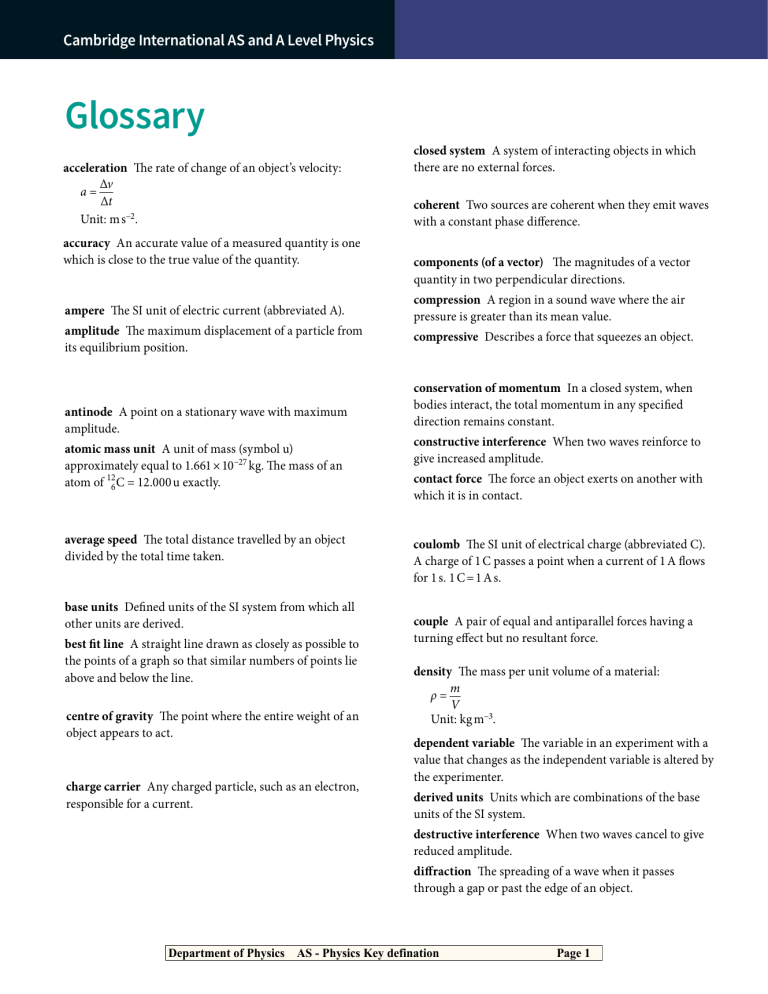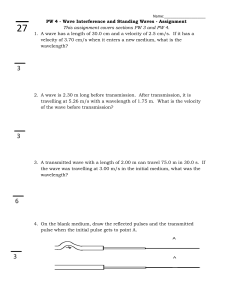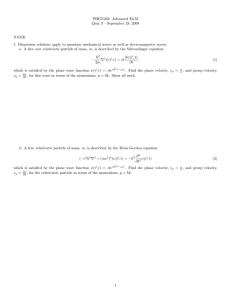
Cambridge International AS and A Level Physics Glossary acceleration The rate of change of an object’s velocity: Δv a= Δt Unit: m s−2 . accuracy An accurate value of a measured quantity is one which is close to the true value of the quantity. ampere The SI unit of electric current (abbreviated A). amplitude The maximum displacement of a particle from its equilibrium position. antinode A point on a stationary wave with maximum amplitude. atomic mass unit A unit of mass (symbol u) approximately equal to 1.661 × 10−27 kg. The mass of an atom of 126 C = 12.000 u exactly. average speed The total distance travelled by an object divided by the total time taken. base units Defined units of the SI system from which all other units are derived. best fit line A straight line drawn as closely as possible to the points of a graph so that similar numbers of points lie above and below the line. centre of gravity The point where the entire weight of an object appears to act. charge carrier Any charged particle, such as an electron, responsible for a current. closed system A system of interacting objects in which there are no external forces. coherent Two sources are coherent when they emit waves with a constant phase difference. components (of a vector) The magnitudes of a vector quantity in two perpendicular directions. compression A region in a sound wave where the air pressure is greater than its mean value. compressive Describes a force that squeezes an object. conservation of momentum In a closed system, when bodies interact, the total momentum in any specified direction remains constant. constructive interference When two waves reinforce to give increased amplitude. contact force The force an object exerts on another with which it is in contact. coulomb The SI unit of electrical charge (abbreviated C). A charge of 1 C passes a point when a current of 1 A flows for 1 s. 1 C = 1 A s. couple A pair of equal and antiparallel forces having a turning effect but no resultant force. density The mass per unit volume of a material: m ρ= V Unit: kg m−3. dependent variable The variable in an experiment with a value that changes as the independent variable is altered by the experimenter. derived units Units which are combinations of the base units of the SI system. destructive interference When two waves cancel to give reduced amplitude. diffraction The spreading of a wave when it passes through a gap or past the edge of an object. Department of Physics AS - Physics Key defination Page 1 Cambridge International AS and A Level Physics displacement The distance moved by an object in a particular direction (measured from a fixed starting point). Doppler effect The change in frequency or wavelength of a wave observed when the source of the wave is moving towards or away from the observer (or the observer is moving relative to the source). drag A force that resists the movement of a body through a fluid. drift velocity, mean The average speed of a collection of charged particles when a current flows. dynamics The study of motion using quantities such as force and mass. e.m.f. The total work done when unit charge is moved round a complete circuit. Unit: J C−1 or volt (V). −1. efficiency The ratio of useful output energy to the total input energy for a device, expressed as a percentage: useful output energy × 100% efficiency = total input energy elastic limit The value of stress beyond which an object will not return to its original dimensions. elastic potential energy Energy stored in a stretched or compressed material. electric charge A property of a body that gives rise to a force on the body when it is within an electric field. electrical resistance The ratio of potential difference to current. Unit: ohm (Ω). electromagnetic spectrum The family of waves that travel through a vacuum at a speed of 3.00 × 108 m s−1. electronvolt The energy gained by an electron travelling through a p.d. of 1 volt. 1 eV = 1.60 × 10−19 J. elementary charge The smallest unit of charge that a particle or an object can have. It has a magnitude of 1.60 × 10−19 C. equations of motion Four interrelated equations that can be used to determine the displacement, initial velocity, final velocity and acceleration of a body moving with constant acceleration. equilibrium An object in equilibrium is either at rest or travelling with a constant velocity because the resultant force on it is zero. errors Inaccuracies when taking measurements. extension The change in the length of a material from its original length. force constant The ratio of force to extension for a spring or a wire. Unit: N m−1. free-body force diagram A diagram showing all the forces acting on an object (but not the forces it exerts on other objects). frequency The number of oscillations per unit time. Unit: hertz (Hz). fundamental frequency The lowest-frequency stationary wave for a particular system. gravitational field strength The gravitational force experienced by an object per unit mass: F g= m hadron Any particle which is affected by the strong nuclear force, made from two or three quarks or anti-quarks. harmonic A wave of frequency n times the fundamental frequency, where n is an integer. Hooke’s law The extension produced in an object is proportional to the force producing it. independent variable The variable in an experiment with a value that is altered by the experimenter. inelastic A collision is inelastic when kinetic energy is not conserved; some is transferred to other forms such as heat. Momentum and total energy are always conserved. inertia A measure of the mass of an object. A massive object has large inertia. instantaneous speed The speed of an object measured over a very short period of time. intensity The power transmitted normally through a surface per unit area: energy A calculated quantity which is conserved during power intensity = any change; that which is transferred when a force does cross-sectional area work. Unit: W m−2. Department of Physics AS - Physics Key defination Page 2 Cambridge International AS and A Level Physics interference The formation of points of cancellation and reinforcement where two coherent waves pass through each other. internal resistance The resistance of an e.m.f. source. The internal resistance of a battery is due to the chemicals within it. isotopes Nuclei of the same element with a different number of neutrons but the same number of protons. I–V characteristic A graph of current against voltage for a particular component of an electrical circuit. kinematics The study of motion using quantities such as time, distance, displacement, speed, velocity and acceleration. mass A measure of the amount of matter within an object. Unit: kilogram (kg). mean drift velocity The average speed of a collection of charged particles when a current flows. moment The moment of a force about a point is the magnitude of the force, multiplied by the perpendicular distance of the point from the line of the force. Unit: N m. monochromatic Describes light of a single frequency. neutrino A lepton, released during beta-decay. neutron number The number of neutrons in the nucleus of an atom. newton The force that will give a 1 kg mass an acceleration of 1 m s−2 in the direction of the force. 1 N = 1 kg m s−2. kinetic energy Energy of an object due to its motion. Newton’s first law of motion An object will remain at rest or keep travelling at constant velocity unless it is acted on by a resultant force. Kirchhoff ’s first law The sum of the currents entering any point (or junction) in a circuit is equal to the sum of the currents leaving that same point. This law represents the conservation of charge. Newton’s second law of motion The resultant force acting on an object is equal to the rate of change of its momentum. The resultant force and the change in momentum are in the same direction. Kirchhoff ’s second law The sum of the e.m.f.s round a closed loop in a circuit is equal to the sum of the p.d.s in that same loop. Newton’s third law of motion When two bodies interact, the forces they exert on each other are equal and opposite. lepton A sub-atomic particle which is not affected by the strong nuclear force. light-dependent resistor (LDR) A resistor whose resistance decreases as the intensity of light falling on it increases. light-emitting diode (LED) A semiconductor component that emits light when it conducts electricity. linear momentum The product of an object’s mass and its velocity, p = mv. Momentum is a vector quantity. longitudinal wave A wave in which the particles of the medium oscillate along the direction in which the wave travels. lost volts The difference between the e.m.f. and the terminal p.d. in a circuit. It is equal to the voltage across the internal resistance. Department of Physics node A point on a stationary wave with zero amplitude. nuclear model of the atom A model of the atom in which negative charges (electrons) are distributed outside a tiny nucleus of positive charge. nucleon number The number of neutrons and protons in the nucleus of an atom (also called mass number). nucleon A particle found in an atomic nucleus, i.e. a neutron or a proton. nucleus The tiny central region of the atom that contains most of the mass of the atom and all of its positive charge. nuclide A specific combination of protons and neutrons in a nucleus. number density The number of particles, such as free electrons, per unit volume in a material. Ohm’s law The current in a metallic conductor is directly proportional to the potential difference across its ends, provided its temperature remains constant. AS - Physics Key defination Page 3 Glossary parallel Describes components connected side-by-side in a circuit. path difference The difference in the distances travelled by two waves from coherent sources at a particular point. perfectly elastic A collision is perfectly elastic when kinetic energy is conserved. Momentum and total energy are always conserved. period The time taken by an object (e.g. a planet) to complete one cycle (e.g. an orbit). The period is also the time taken for one complete oscillation of a vibrating object. Unit: second (s). phase Refers to the point that an oscillating mass has reached in a complete cycle. phase difference The difference in the phases of two oscillating particles, expressed in degrees or radians. Polarisation oscillations are in a single direction, which is perpendicular to the direction of propagation (of the wave) positron An anti-electron. potential difference (p.d.) The energy lost per unit charge by charges passing through a component. Unit: J C−1 or volt (V). potential divider A circuit in which two or more components are connected in series to a supply. The output voltage from the circuit is taken across one of the components. potentiometer A circuit which allows the measurement of an e.m.f. by comparison with a known e.m.f. power The rate at which energy is transferred or the rate at which work is done. Unit: watt (W). precision The smallest change in value that can be measured by an instrument or an operator. A precise measurement is one made several times, giving the same, or very similar, values. pressure The force acting normally per unit area of a surface: F p= A Unit: N m−2 or pascal (Pa). principle of conservation of energy The idea that, within a closed system, the total amount of energy in all its forms is unchanged during any change. Department of Physics AS - Physics Key defination Page 4 Cambridge International AS and A Level Physics principle of moments For an object in equilibrium, the sum of clockwise moments about a point is equal to the sum of anticlockwise moments about the same point. principle of superposition When two or more waves meet at a point, the resultant displacement is the sum of the displacements of the individual waves. progressive wave A wave that carries energy from one place to another. projectile Any object thrown in the Earth’s gravitational field. proton number The number of protons in the nucleus of an atom (also called atomic number). quarks The fundamental particles of which hadrons are made. range The horizontal distance covered by an object. red shift the change in frequency or wavelength of a spectral line observed when the source of light is moving away from the observer; see Doppler effect. relative speed The magnitude of the difference in velocities between two objects. resistivity A property of a material, a measure of its electrical resistance, defined by: RA ρ= L Unit: Ω m. resistor An electrical component whose resistance in a circuit remains constant, is independent of current or potential difference. resultant force The single force that has the same effect as all of the forces acting on an object. speed The rate of change of the distance moved by an object: distance speed = time Unit: m s−1. stationary wave A wave pattern produced when two progressive waves of the same frequency travelling in opposite directions combine. It is characterised by nodes and antinodes. Also known as a standing wave. strain The extension per unit length produced by tensile or compressive forces: extension strain = original length strain energy The potential energy stored in an object when it is deformed elastically. stress The force acting per unit cross-sectional area: force stress = cross-sectional area strong nuclear force A fundamental force which acts between hadrons. systematic error An error in readings which is repeated throughout an experiment, producing a constant absolute error or a constant percentage error. tensile Associated with tension or pulling, e.g. a tensile force. terminal p.d. The potential difference across an external resistor connected to an e.m.f. source. terminal velocity The maximum velocity of an object travelling through a fluid. The resultant force on the object is zero. thermistor A device whose electrical resistance changes when its temperature changes. scalar quantity A scalar quantity has magnitude but no direction. threshold voltage The minimum forward bias voltage across a light-emitting diode (LED) when it starts to conduct and emit light. semiconductor diode An electrical component made from a semiconductor material (e.g. silicon) that only conducts in one direction. A diode in ‘reverse bias’ has an infinite resistance. torque of a couple The product of one of the forces of a couple and the perpendicular distance between them. Unit: N m. series A term used when components are connected endto-end in a circuit. transverse wave A wave in which the particles of the medium oscillate at right angles to the direction in which the wave travels. triangle of forces A closed triangle drawn for an object in equilibrium. The sides of the triangle represent the forces in both magnitude and direction. Department of Physics AS - Physics Key defination Page 5 Cambridge International AS and A Level Physics unified atomic mass unit A convenient unit used for the mass of atomic and nuclear particles (1 u is equal to the mass of a 126C carbon atom). 1 u = 1.66 × 10−27 kg uniform acceleration Acceleration that remains constant. uniform motion Motion of an object travelling with a constant velocity. upthrust The upward force that a liquid exerts on a body floating or immersed in a liquid. Young modulus The ratio of stress to strain for a given material, resulting from tensile forces, provided Hooke’s law is obeyed: stress Young modulus = strain Unit: pascal (Pa; or MPa, GPa). zero error A systematic error in an instrument that gives a non-zero reading when the true value of a quantity is zero. vector addition Using a drawing, often to scale, to find the resultant of two or more vectors. vector quantity A quantity which has both magnitude and direction. vector triangle A triangle drawn to determine the resultant of two vectors. velocity The rate of change of the displacement of an object: change in displacement velocity = time Unit: m s−1. You can think of velocity as ‘speed in a certain direction’. viscous forces Forces that act on a body moving through a fluid that are caused by the resistance of the fluid. wave A periodic disturbance travelling through space, characterised by a vibrating medium. wavelength The distance between two adjacent peaks or troughs in a wave. weak nuclear force A fundamental force, involved in radioactive β-decay. weight The force on an object caused by a gravitational field acting on its mass: weight = mass × acceleration of free fall Unit: newton (N). work done The product of the force and the distance moved in the direction of the force. Department of Physics AS - Physics Key defination Page 6




